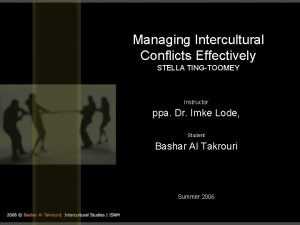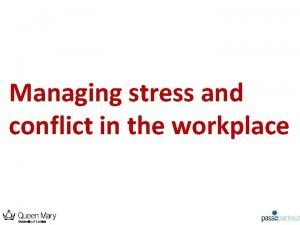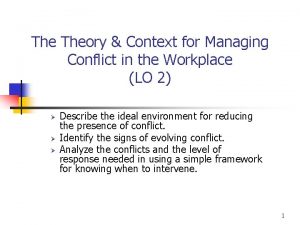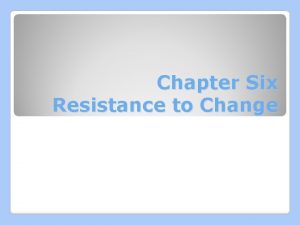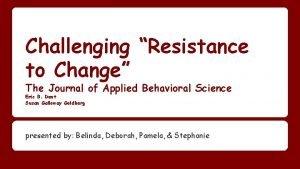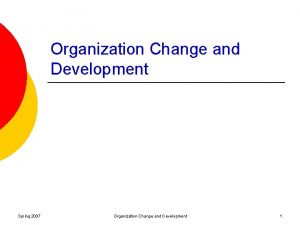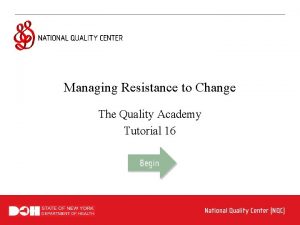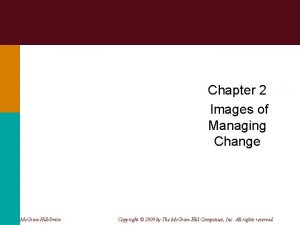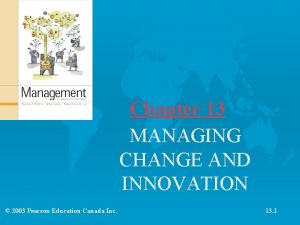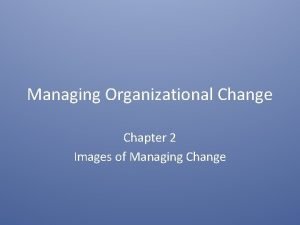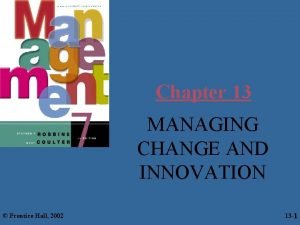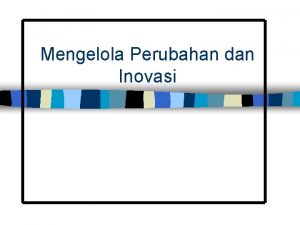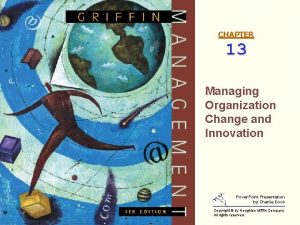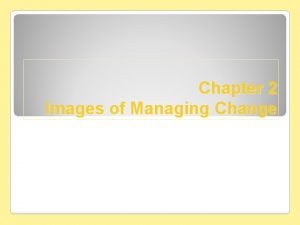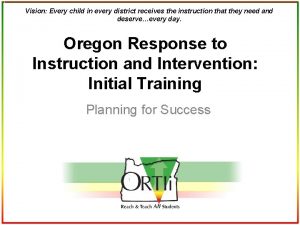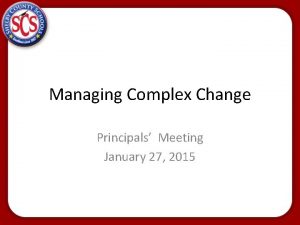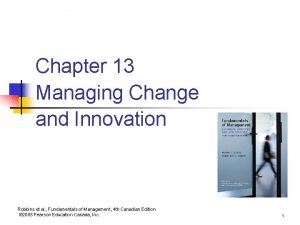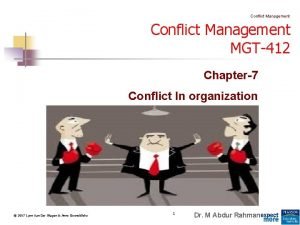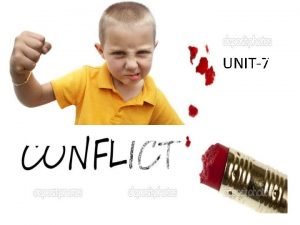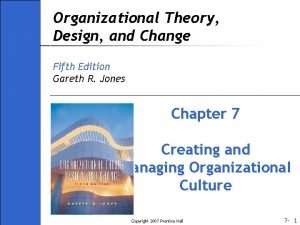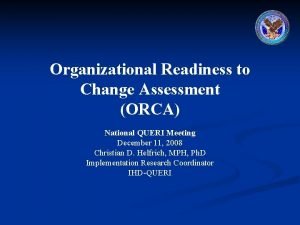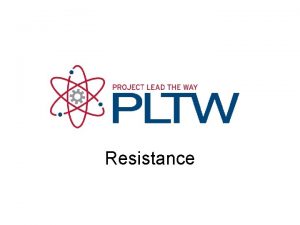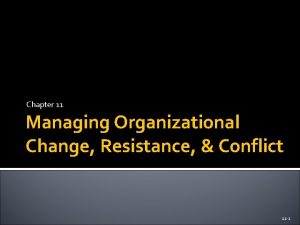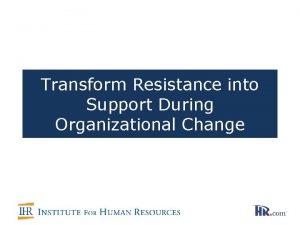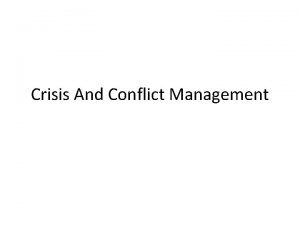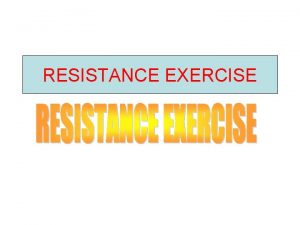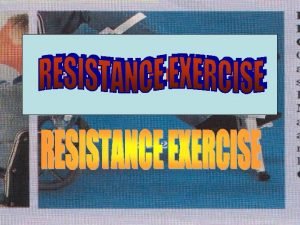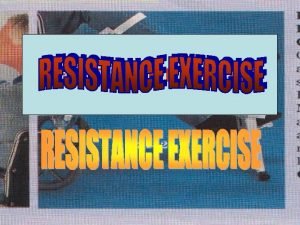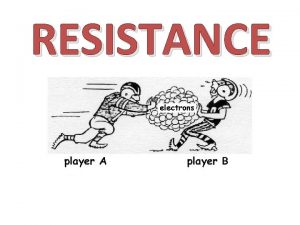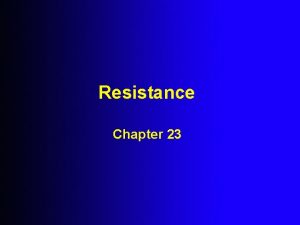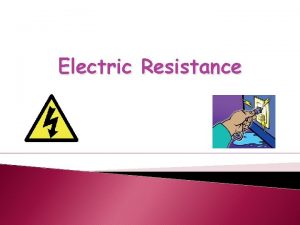Managing Organizational Change Resistance Conflict 11 1 Copyright

































- Slides: 33

Managing Organizational Change, Resistance, & Conflict 11 -1 Copyright 2012 John Wiley & Sons, Inc.

Change and Organizational Impact Projects often cause changes in organizations, and some people may lose their jobs when a project is completed. Project managers must learn to identify, understand, and work with a variety of stakeholders Examples of Stakeholder Impacts from cases 2

Reactions to Change We have all been through change - but how do we think about and manage it? Dealing with the people issues, or soft side of technology, is an area that most technical people do not enjoy. Many technical people and managers naively believe that the users within the organization will gladly embrace a new system if it is built properly. 11 -3

Managers & Technical People May Have The False Beliefs People want this change. Monday morning we’ll turn on the system and they’ll use it. A good training program will answer all of their questions and then they’ll love it. Our people have been through a lot of change – what’s one more change going to matter? We see the need for helping our people adjust, but we had to cut something. They have two choices. They can change or they can leave. 11 -4

In Reality, … 11 -5

Change Management Defined by the Gartner Group § The transforming of the organization so it is aligned with the execution of a chosen corporate business strategy. It is the management of the human element in a large-scale change project. 11 -6

Assimilation of change require Assimilating Change Threshold Time 11 -7

Change is a Process Driving Forces Present State Unfreezing Resisting Forces Transition State Changing Desired State Refreezing Force Field Analysis – Lewin, 1951 11 -8

Emotional Responses to Change active Emotional Response anger acceptance bargaining stability passive denial shock testing depression Time Elizabeth Kubler- Ross, 1969 11 -9

Five Stages of Grieving Denial § Shock and disbelief Anger § Blaming others for the change Bargaining § Attempts to make deals to avoid the change § Looks for ways to extend the status quo Depression § Admits that change is inevitable and understands the impact Acceptance § Coming to grips with the change § Moving on to the new state 11 -10

Impact of Organizational Change (Leavitt’s Model) People Structure Technology Task 11 -11

Reactions to Change may § § § Be an ending Mean giving something up Be stressful Be easier for those initiating the change Be the basis for resistance and conflict Change the “rules for success” 11 -12

Change Management Plan 11 -13

Assess Willingness, Readiness, and Ability to Change 11 -14

Develop or Adopt a Strategy for Change Rational–Empirical Approach Normative-Reeducation Approach Power-Coercive Approach Environmental-Adaptive Approach 11 -15

Implement the Change Management Plan and Track Progress 11 -16

Evaluate Experience and Develop Lessons Learned Experiences should be documented and made available to other project teams 11 -17

Best Practices Provide consistent communication and involvement – WIIFM (What’s In It For Me) Determine support needs - where do people go for help and information? Measure and communicate progress (Quick Wins) Build the need for change (“Burning Platform”) Ensure visible, consistent sponsorship Allow the disenchanted to vent § Listen, listen, … and listen some more 11 -18

Resistance and Conflict 11 -19

Why Do People Resist Change? 11 -20

Conflict Management Focuses on preventing, managing, or resolving conflicts. It is important to identify potential conflicts as early as possible so that the conflict can be addressed. Although conflict can be positive and help form new ideas and establish commitment, negative conflict left unresolved can lead to damaged relationships, mistrust, unresolved issues, continued stress, dysfunctional behavior, and low productivity and morale. 11 -21

Although conflict is one of the things most of us dislike intensely, it is inevitable. Most often when we try to avoid conflict, it will nevertheless seek us out. Some people wrongly hope that conflict will go away if it is ignored. In fact, conflict ignored is more likely to get worse, which can significantly reduce project performance. The best way to reduce conflict is to confront it. (Verma, 1998, p. 367) 11 -22

Conflict Management Style Quiz Add the corresponding statements for each of the styles below to find out how you would handle conflicts: Style 1: Style 2: Style 3: Style 4: Style 5: 1, 5, 7 4, 9, 12 6, 10, 15 3, 11, 14 2, 8, 13 11 -23

Types of Conflict Traditional View Contemporary View Interactionist View 11 -24

Approaches to Conflict 11 -25

Approach to Conflict Situation Each conflict situation is unique and the choice of an approach to resolve conflict depends on: 11 -26

Conflict and the Project Team Project managers must lead their teams in performing various project activities After assessing team performance and related information, the project manager must decide: § if changes should be requested to the project § if corrective or preventive actions should be recommended § if updates are needed to the project management plan or organizational process assets. 27

Conflict Handling Modes 1. Confrontation 2. Compromise 3. Smoothing 4. Forcing 5. Withdrawal 6. Collaborating http: //www. youtube. com/watch? v=6 x. Ckh. V 7 zhuw 28

Can Conflict Be Good? 29

Common Sources of Conflict Work scope Resource assignments Schedule Costs Technical opinions Priorities of resource time Administrative procedures Responsibilities Personality clashes 30

Root Cause of Conflict The PM has final responsibility to resolve or manage any conflict that affects project success. For example, suppose two people are yelling at each other during a meeting. Asking them to not yell fixes the symptom, but not the root cause of the conflict, which may be a difference of opinion about an issue due to different assumptions being made by each person. Part 3 - Project Teams & Conflict 31

Five Dysfunctions of a Team The five dysfunctions of teams are 1. Absence of trust 2. Fear of conflict 3. Lack of commitment 4. Avoidance of accountability 5. Inattention to results *Lencioni, Patrick, “Overcoming the Five Dysfunctions of a Team, ” Jossey-Bass: San Francisco, CA (2005), p. 3. 32

General Advice on Teams Be patient with your team Fix the problem instead of blaming people Establish regular, effective meetings Allow time for teams to go through the basic team-building stages Limit the size of work teams to three to seven members 33
 Introduction of filtration
Introduction of filtration Friction and air resistance
Friction and air resistance Managing intercultural conflict effectively
Managing intercultural conflict effectively Mainwaring strategies for managing conflict
Mainwaring strategies for managing conflict Conflict in psychology
Conflict in psychology Stress and conflict introduction
Stress and conflict introduction Ways of managing conflict in the community
Ways of managing conflict in the community Managing conflict theory
Managing conflict theory Resistance to change images
Resistance to change images Resistance to change in an organization
Resistance to change in an organization Challenging resistance to change
Challenging resistance to change Forces for change
Forces for change Resistance to change
Resistance to change Managing complex change
Managing complex change Images of change management
Images of change management Chapter 18 organizational change and stress management
Chapter 18 organizational change and stress management Contemporary issues in managing change
Contemporary issues in managing change Navigator image of managing change
Navigator image of managing change The calm waters metaphor
The calm waters metaphor Managing change and innovation
Managing change and innovation Managing change and innovation
Managing change and innovation Images of managing change
Images of managing change Managing complex change matrix
Managing complex change matrix Ambrose managing complex change
Ambrose managing complex change White-water rapids metaphor
White-water rapids metaphor Management of organizational conflict
Management of organizational conflict Conflict can be defined as
Conflict can be defined as Internal and external conflict worksheets
Internal and external conflict worksheets What is conflict and conflict resolution?
What is conflict and conflict resolution? External conflict definition
External conflict definition Change adalah
Change adalah Organizational change adalah
Organizational change adalah Organizational theory design and change
Organizational theory design and change Organizational readiness to change assessment (orca) pdf
Organizational readiness to change assessment (orca) pdf


